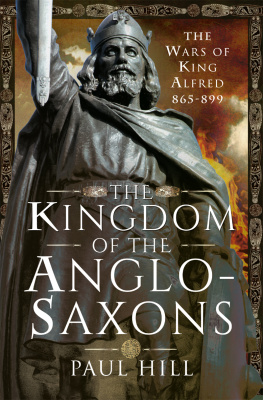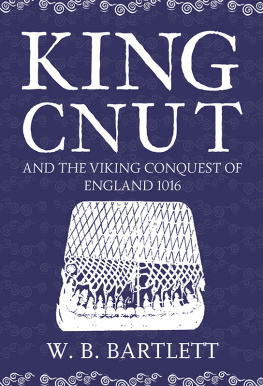Contents
Appendix 1
Appendix 2
Appendix 3
England fell under Danish control around 1,000 years ago, in 1016. The motive of the invaders was not to settle land but to gain riches, wreak revenge and establish political and military hegemony over a rich and prosperous country. For the best part of three decades, successive Danish kings ruled in England as well as Denmark and much of Norway. Had each king not been short-lived, an Englishmans national heritage might now be considered in large part Scandinavian.
Viking attacks on England had been an overriding menace for more than 200 years. Historians identify two discrete Viking ages: the first ( c . 793954) when three of the four old Anglo-Saxon kingdoms of England fell for a time under Viking control, before being won back; the second spanning much of the reign of Aethelred II (9781016), when sustained attacks from successive, voracious Scandinavian warlords toppled English rule altogether. The first two chapters of this book cover the first Viking Age; the rest of the book focuses on the second. The narrative spans a period of our history when the way armies were organised and how they fought is not fully understood; the locations of even the larger battles are unknown or disputed. Assandun, the culminating battle of Cnuts campaign of conquest in 1016, was fought in Essex, but whether at Ashdon, on the borders with Cambridgeshire, or at Ashingdon, in the south-east of the county, is unclear. Some battles are not referenced in the mainstream chronicles. Only tantalisingly brief mentions occur in little-known Celtic annals or in later Icelandic sagas of dubious provenance. Over fifty known battles were fought between Anglo-Saxons and Vikings in England from the late eighth century up until 1016, approximately one every four years on average, but they often arrived in clusters. Outside of unusually eventful years such as 871, 893 and 1016, battles were uncommon, and only a few were major cataclysms (see the Appendix 1 Battle Chronology 7961016).
Encounters could be quite formal affairs. A lengthy period of religious observance, including the hearing of Mass, took place on the Christian side before the Battle of Ashdown (871). Large communities of monks accompanied the English army into battle at Assandun. An Old English poem known as The Battle of Maldon (991) describes the English leader Byrhtnoth allowing a stronger Viking force to cross a causeway unopposed, enabling both sides to fight on an equal footing. Although rarely sought, set-piece battles at this time seldom appear to have been rushed.
If the military history is elusive, the geography of the time is no less so. Forests were more extensive than today; roads across mountainous districts, such as the Pennines, almost non-existent. Extensive regions of marshland curtailed or funnelled movement. Areas such as the Humberhead Levels (circumscribing the borders of Yorkshire, Lincolnshire and Nottinghamshire), Romney Marsh in Kent and the Somerset Levels (all now dry land), were in early medieval times permanently or seasonally waterlogged and subject to regular inundation from the sea. The political term Northumbria attests to the Humber being a major barrier between North and South, splitting the country geographically. The sinuous course of the Thames (demarcating the boundary between Wessex to the north and Mercia to the south) underwrote the importance of heavily garrisoned fords at flashpoints such as Wallingford, Oxford and Abingdon. Seaways and navigable river systems such as the Trent and the Severn often afforded the safest and quickest mode of travel for raiding armies, and islands such as Mersea in Essex, Sheppey and Thanet in Kent, and the Isle of Wight became important Viking strongholds.
The most densely populated areas of England in early medieval times were parts of Lincolnshire, East Anglia and east Kent. Other, lesser concentrations of peoples existed in south Somerset and along the South Coast. Population estimates range from 1.25 to 2 million people in the late eleventh century, a marked decline from more prosperous and secure Roman times, when the population is estimated to have peaked at as many as 4 million. It would not be until the 1300s that numbers would again reach such levels; only to decline again with the arrival of the Black Death in the Middle Ages.
Early English chroniclers routinely described Viking invaders up until the eleventh century as raiding-armies, and sometimes used the same terminology to describe local forces striking back. In its mildest form raiding might equally well be termed foraging, the procurement of forage and supplies being (as in any period of history) an on-going requirement for large armies, and one needing to be undertaken ever further afield, for obvious reasons. But Viking raiding armies were not noted for their mildness. If contemporary accounts are to be believed, their sorties were aggressively undertaken, with local peasant communities bearing the brunt of the violence; men were killed and women and children enslaved. Such Viking depredations resulted in untold misery for captives sold on in the slave marts of Dublin and Rouen. Harrying of an opponents land differed only in motivation. It was an overtly warlike activity which both sides engaged in, designed to deny resources to an enemy or to punish transgression. Areas harried were systematically destroyed by fire and sword. Villages were razed to the ground and inhabitants indiscriminately slaughtered.
To the early English chroniclers, the Vikings were simply referred to as heathen men or, more often, Danes. Only later was the term Viking commonly used, thought variously to mean sea pirate, trader, traveller or men of the fjords. Irish chroniclers made a clear and early distinction between the Norse Finngaill (white foreigners) and Danish Dubhgaill (black foreigners), whose fierce, hereditary rivalry turned all Ireland into a battleground in the ninth and tenth centuries, and whose depredations resulted in enormous losses to the Irish in destroyed manuscripts and precious religious objects. The route from Oslo fjord to Dublin became known as the sea road and the islands and archipelagos of northern Britain became established settlement points and stopovers for seagoing Viking communities. Seafaring acumen and fierce fighting skills gave the newcomers mobility and martial advantage capable of overwhelming the relatively flimsy, static defences of much of Christianised Europe. Even the mighty Carolingian Empire was rocked by the severity of their attacks, and kings such as Charles the Bald and Charles the Fat were forced to pay tribute to avoid protracted warfare in the same way as a number of Anglo-Saxon kings, including Alfred the Great (d. 899) and Aethelred II. River systems and estuaries which acted as buffers between rival petty kingdoms in Ireland, Britain and on the Continent were highways for the invaders, whose shallow-drafted boats were able to penetrate deep into the interior before disgorging raiding parties, forerunners of full-scale armies.
As early as the eighth century, warships are thought to have been quite different from other mercantile craft, and were designed to be distinctively long in proportion to their width. Eight knots was a likely maximum speed for a typical longship under oars, though it was not a pace likely to be kept up for long, and would have been impossible to achieve against a swift tide. Size mattered. The number of warriors on board determined the ships combat potential and speed. King Olaf Tryggvason of Norway (d. 999) is credited with having a flagship capable of carrying 500 men. Such enormous ships were presumably quite rare; their size was also likely exaggerated for dramatic effect. More typically, longships are thought to have carried around forty to forty-five men when at full complement three men to an oar, depending on space allowing for one or more relief crews, an important consideration in wartime or when undertaking long-distance voyages.















